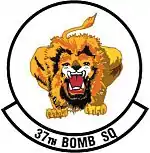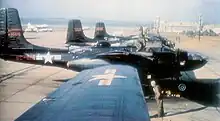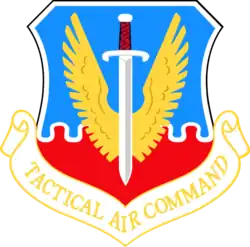37th Bomb Squadron
 | |
|---|---|
 | |
| Active | 1917–1919; 1933–1938; 1940–1945; 1947–1948; 1952–1958; 1977–1982; 1987–present |
| Country | |
| Branch | |
| Role | Heavy bomber |
| Part of | Global Strike Command |
| Garrison/HQ | Ellsworth Air Force Base |
| Nickname(s) | Tigers[1] |
| Motto(s) | “Harrumph!”[2] |
| Mascot(s) | Billy the tiger |
| Engagements | American Theater (World War II) Mediterranean Theater of Operations European Theater of Operations Korean War[3] Operation Desert Fox Operation Allied Force Operation Enduring Freedom Operation Iraqi Freedom Operation Odyssey Dawn Operation Freedom's Sentinel Operation Inherent Resolve |
| Decorations | Distinguished Unit Citation Air Force Meritorious Unit Award Air Force Outstanding Unit Award with "V" Device French Croix de Guerre with Palm Republic of Korea Presidential Unit Citation |
| Insignia | |
| 37th Bombardment Squadron emblem[lower-alpha 2][3] | .png.webp) |
| 37th Bomb Squadron emblem[lower-alpha 3][4] |  |
| 37th Pursuit Squadron emblem[lower-alpha 4][4][5] |  |
The 37th Bomb Squadron is part of the 28th Bomb Wing at Ellsworth Air Force Base, South Dakota. It operates Rockwell B-1 Lancer aircraft providing strategic bombing capability.
The squadron is one of the oldest in the United States Air Force, its origins dating to 13 June 1917, when the 37th Aero Squadron was organized at Kelly Field, Texas. The squadron deployed to France as part of the American Expeditionary Force during World War I and served as a training unit until returning to the US for demobilization. It was active in the interwar years at Langley Field, Virginia as a pursuit and attack squadron.
The squadron saw combat as the 37th Bombardment Squadron, a Martin B-26 Marauder unit in the Mediterranean Theater of Operations during World War II, earning two Distinguished Unit Citations (DUC) for its performance. It was inactivated after the war's end, although it was briefly active as a paper unit in 1947–1948.
The squadron was again activated during the Korean War, when it replaced a reserve unit that was being returned to reserve duty. Flying night intruder missions with Douglas B-26 Invaders, the squadron earned another DUC before the truce in July 1953. In 1955 it returned to the United States and became one of the first jet tactical bomber units, flying Martin B-57 Canberras and Douglas B-66 Destroyers. After a brief deployment to England, the squadron once again inactivated.
In 1977, the 37th became part of the Strategic Air Command, flying Boeing B-52 Stratofortresses until 1982. It assumed its present role in 1987.
The squadron is an honorary member of the NATO Tiger Association
History
World War I
Established on 13 June 1917 at Kelly Field in Texas, the 37th Aero Squadron moved to France in early September. After a short spell at Étampes (18–23 September), it settled at the Issoudun Aerodrome,[6] participating at the installation of the Third Aviation Instruction Center. Once declared operational, it started flight training for newly arrived American pilots and crew members.
Reaching Bordeaux c. 6 January 1919, the squadron stayed there until 18 March, when it board a transport to bring it back to the United States where it was demobilized.[6]
Inter-war years
Reactivated at Langley Field, Virginia in September 1933 at as the 37th Pursuit Squadron, the squadron was attached to the 8th Pursuit Group and equipped with Curtiss P-6 Hawks, in March 1935 it became the 37th Attack Squadron with Curtiss A-8 Shrike and Northrop A-17 Nomad attack aircraft. In January 1938, the squadron was inactivated.[3]
World War II
Early operations and training
The squadron was redesignated the 37th Bombardment Squadron and activated at Barksdale Field, Louisiana on 1 February 1940 with Douglas B-18 Bolo bombers as one of the original squadrons of the 28th Composite Group, which was training for deployment to Alaska. However, when the 28th Group moved to Alaska in February 1941, the squadron remained in the United States, at Lowry Field, Colorado. In its place, the 73d Bombardment Squadron of the 17th Bombardment Group moved to Alaska in March. The exchange of squadrons was completed in April and May 1941, when the 37th was reassigned to the 17th Group and the 73d to the 28th Group. In June, the squadron moved to Pendleton Field, Oregon and was collocated with its parent group for the first time since the squadron's 1940 activation.[7]
At Pendleton, the squadron transitioned into the North American B-25 Mitchell medium bomber, when the 17th Group became the first Air Corps unit to receive the new bomber.[8] In August, it received the updated B-25B, that had a much heavier defensive armament, dictated by the results of combat reports coming in from Europe.[9] Following the attack on Pearl Harbor, the 37th flew antisubmarine patrols off the Pacific coast until about March 1942. It moved to Lexington County Airport, South Carolina, on 9 February 1942 in order to meet the greater threat from German submarines operating off the East Coast.[3]
Doolittle raid
.jpg.webp)
Planning for a retaliatory bombing raid on Japan began in December 1941, and twenty-four B-25Bs were diverted from the 17th Bombardment Group, which was the only B-25 unit in the Air Corps, and volunteers from its four squadrons, including the 37th, were recruited, the crews being told only that this was a secret and dangerous mission. The volunteers trained at Eglin Field, Florida. Upon completion of training, they left Eglin for McClellan Field, California for final modifications to the B-25s before moving to Naval Air Station Alameda, where the bombers were loaded on the USS Hornet (CV-8) for the raid.[10]
Combat operations in the Mediterranean

The remainder of the squadron remained in Columbia, flying antisubmarine patrols until 23 June when it moved to Barksdale Field, where it began transitioning into the Martin B-26 Marauder.[3]
In November 1942, the squadron deployed to North Africa, arriving at Telergma Airport, Algeria in December 1942 following Operation Torch's initial landings, becoming part of XII Bomber Command. The squadron flew interdiction and close air support, missions, bombing bridges, rail lines, marshalling yards, harbors, shipping, gun emplacements, troop concentrations and other enemy targets in Algeria and later Tunisia supporting American and later Allied ground forces as they moved east, contributing to the defeat of Axis forces in Africa by May 1943.[11][12]
During 1943, the 37th participated in Operation Corkscrew, the reduction of Pantelleria. It supported Operation Husky, the Allied invasion of Sicily and Operation Avalanche, the invasion of Italy. During the drive toward Rome, the squadron was awarded a Distinguished Unit Citation for its attacks on airfields near Rome on 13 January 1944. It was also awarded the French Croix de Guerre with Palm for its operations in Italy between April and June.[11]
The unit provided tactical air support in the liberation of Sardinia and Corsica. From airfields in Corsica, the 432d supported Allied ground forces during Operation Dragoon, the invasion of southern France in August 1944. It moved to Southern France and bombed enemy targets during the Allied drive northward. It earned a second Distinguished Unit Citation for bombing attacks on enemy defenses near Schweinfurt, Germany just before the end of the war on 10 April 1945.[11]
The squadron remained in Europe after V-E Day. It became part of the occupation forces, and participated in the disarmament of Germany.[11] It moved to the American Occupation Zone in Austria.[13] The squadron returned to France to stage for its return to the United States, where it was inactivated in late November 1945.[11][3]
Korean War

The squadron was reactivated in May 1947 by Tactical Air Command but it was not manned or equipped. It was inactivated in September 1948.[3]
The squadron was activated at Pusan East Air Base, Korea on 10 May 1952, when it assumed the mission, personnel and Douglas B-26 Invaders of the 729th Bombardment Squadron. The 729th was a reserve unit that had been called to active duty for the Korean War and was being returned to reserve status.[14] The squadron continued the night bombing operations of the 729th, concentrating on attacks on enemy lines of communication and troop concentrations. In 1953, the squadron focused on attacking rail rolling stock, facilities and supplies. Using Invaders with glass noses,[lower-alpha 6] the squadron developed techniques for conducting armed reconnaissance missions against locomotives and freight cars and began flying missions employing these tactics in February 1953. It participated in Operation Spring Thaw and starting in March, attacked southbound routes along the East Coast of North Korea. It continued operations until the July 1953 truce, and was awarded its third DUC for its operations.[15]
The 37th remained in Korea as a precaution against the resumption of hostilities. In September 1954, it relocated to Miho Air Base, Japan, It remained in Japan until the spring of 1955, when it returned to the United States for conversion to jet bombers.[3][11]
Tactical jet bomber operations

Re-equipped with Martin B-57 Canberra jet bombers and conducted evaluation testing of the aircraft at Eglin Air Force Auxiliary Field No. 9; transitioned to Douglas B-66B Destroyers in 1956, the first squadron to receive the new tactical bomber. Deployed to RAF Sculthorpe, England briefly in 1958 before returning to Eglin and performing more testing on B-66s with Jet Assisted Take Off (JATO) and until being inactivated later in the year.
Strategic bombardment operations
.jpg.webp)

The squadron joined the 28th Bombardment Wing at Ellsworth Air Force Base, becoming the wing's second Boeing B-52H Stratofortress squadron[16] on 1 January 1977. The squadron continued to fly the "Buff" until October 1982, when it was inactivated.[17]
On 1 January 1987, the squadron activated and transitioned to its current aircraft, the Rockwell B-1B Lancer. Along with all other active bomber units in the air force it changed its name and became the 37th Bomb Squadron on 1 September 1991. In December 1998, it became the first unit to employ the B-1 in combat in support of Operation Desert Fox in Iraq. One year later, crews from the squadron supported Operation Allied Force and flew combat operations in Kosovo and Serbia.[17]
Since the 9/11 attacks, the 37th and its sister squadron at Ellsworth, the 34th Bomb Squadron have joined to provide aircraft and crews to form expeditionary units. These expeditionary units have flown missions contributing to the effort to drive the Taliban from Afghanistan. During this time, the combined squadrons flew 5 percent of the strike missions but released nearly 40 percent of the total bomb tonnage—more than 1,730 tons. Its personnel have also employed the B-1 during Operation Iraqi Freedom, including a strike against high priority leadership targets in Baghdad.[17]
In 2007, the 37th began regular deployments to the Middle East, rotating with other B-1 units, with one year at home station followed by six months deployed. On average squadron members fly over 6,000 combat hours and more than 500 combat sorties per deployment. Squadron personnel supported Libya strike missions during Operation Odyssey Dawn, the first B-1 combat mission launched from the United States to strike overseas targets.[17]
Lineage
- Organized as the 37th Aero Squadron on 13 June 1917
- Demobilized on 15 April 1919
- Reconstituted and redesignated 37th Pursuit Squadron on 24 March 1923
- Activated on 1 September 1933
- Redesignated 37th Attack Squadron on 1 March 1935
- Inactivated on 31 January 1938
- Redesignated 37th Bombardment Squadron (Medium) on 6 December 1939
- Activated on 1 February 1940
- Redesignated 37th Bombardment Squadron, Medium on 9 October 1944
- Inactivated on 26 November 1945
- Redesignated 37th Bombardment Squadron, Light on 29 April 1947
- Activated on 19 May 1947
- Inactivated on 10 September 1948
- Redesignated 37th Bombardment Squadron, Light, Night Intruder on 8 May 1952
- Activated on 10 May 1952
- Redesignated 37th Bombardment Squadron, Tactical on 1 October 1955
- Inactivated on 25 June 1958
- Redesignated 37th Bombardment Squadron, Heavy on 16 June 1977
- Activated on 1 July 1977
- Inactivated on 1 October 1982
- Activated on 1 January 1987
- Redesignated 37th Bomb Squadron on 1 September 1991[18]
Assignments
- Unknown, 13 June 1917
- Third Aviation Instruction Center, September 1917
- Commanding General, Services of Supply, January – 15 April 1919
- 18th Pursuit Group (attached to 8th Pursuit Group), 1 September 1933
- 2d Wing (remained attached to 8th Pursuit Group), 1 March 1935 – 31 January 1938
- 28th Composite Group, 1 February 1940
- 17th Bombardment Group, 23 April 1941 – 26 November 1945
- 17th Bombardment Group, 19 May 1947 – 10 September 1948
- 17th Bombardment Group, 10 May 1952 – 25 June 1958 (attached to 17th Bombardment Wing after 8 June 1957)
- 28th Bombardment Wing, 1 July 1977 – 1 October 1982
- 28th Bombardment Wing, 1 January 1987
- 28th Operations Group, 1 September 1991[19]
Stations
|
|
Aircraft
|
|
See also
- International military intervention against ISIL
- List of American aero squadrons
- List of B-1 units of the United States Air Force
- List of B-52 Units of the United States Air Force
- List of B-57 units of the United States Air Force
- List of Douglas A-26 Invader operators
- List of United States Air Force squadrons
- War on Terror
References
- Explanatory notes
- ↑ The B-1 is one of many aircraft participating in the first large force exercise in the newly expanded Powder River Training Complex.
- ↑ Approved 27 December 1956. Description: On a shield red, edged black, a growling royal Bengal tiger in his natural colors, black, white, light tan: eyeballs light green tongue red. When approved in 1956, the emblem was on a shield, not a disc. Maurer, Combat Squadrons, p. 175. Robertson does not give a date for the change to a disc.
- ↑ Modified and restored c. February 1994. Endicott says the 1934 emblem was restored (on a disc) during the CSAF emblem review. Robertson indicates the 1956 emblem is current, but does not give a date for its reinstatement.
- ↑ Approved 25 July 1934.
- ↑ Aircraft is Martin B-26B-1-MA Marauder, serial 41-17747 Earthquake McGoon. It has flak damage to the left engine nacelle, left wing and wheel well. Note the missing landing gear doors.
- ↑ Some of the unit's B-26s had solid noses with machine guns mounted in them.
- Citations
- ↑ Newberry, Col Stuart W. (10 August 2015). "How Do You Clean The Rug?". U.S. Air Forces Central Command Public Affairs. Retrieved 20 February 2018.
- ↑ Newberry, Col Stuart. "How Do You Clean The Rug?". AFCENT. USAFCENT. Retrieved 21 December 2020.
- 1 2 3 4 5 6 7 8 9 10 11 Robertson, Patsy (11 March 2008). "Factsheet 37 Bomb Squadron (ACC)". Air Force Historical Research Agency. Retrieved 20 February 2018.
- 1 2 Endicott, Active Air Force Wings, p. 540
- ↑ Hubbard, p. 719
- 1 2 Maurer, Combat Squadrons, p. p. 175-176
- ↑ Maurer, Combat Squadrons, pp. 175–176, 268; Maurer, Combat Units, pp. 61–63, 80
- ↑ Baugher, Joe (6 March 2000). "North American B-25 Mitchell". Joe Baugher. Retrieved 15 January 2024.
- ↑ Baugher, Joe (6 March 2000). "North American B-25B Mitchell". Joe Baugher. Retrieved 15 January 2024.
- ↑ Baugher, Joe (12 November 2002). "The Doolittle Tokyo Raid". Joe Baugher. Retrieved 15 January 2024.
- 1 2 3 4 5 6 Maurer, Combat Units, pp. 61–63
- ↑ "17th Bomb Group WWII Stories". 17th/452nd Bomb Wing/Group. 11 August 2009. Retrieved 6 February 2017.
- ↑
- ↑ Endicott, USAF in Korea, p. 70
- ↑ Endicott, USAF in Korea, pp. 68–69
- ↑ Robertson, Patsy (20 November 2009). "Factsheet 28 Bomb Wing (ACC)". Air Force Historical Research Agency. Archived from the original on 4 March 2016. Retrieved 26 June 2014.
- 1 2 3 4 No byline. "Ellsworth AFB Units: 28th Operations Group". 28th Bomb Wing Public Affairs. Retrieved 20 February 2018.
- ↑ Lineage information in Robertson, except as noted.
- ↑ Assignment information in Robertson, except as noted.
- 1 2 Station number in Johnson.
- ↑ Station number in Endicott, USAF in Korea, pp. 177–178.
Bibliography
![]() This article incorporates public domain material from the Air Force Historical Research Agency
This article incorporates public domain material from the Air Force Historical Research Agency
- Endicott, Judy G. (1998). Active Air Force Wings as of 1 October 1995 and USAF Active Flying, Space, and Missile Squadrons as of 1 October 1995 (PDF). Air Force History and Museums Program. Washington, DC: Office of Air Force History. ASIN B000113MB2. Retrieved 2 July 2014.
- Endicott, Judy G., ed. (2001). The USAF in Korea, Campaigns, Units and Stations 1950–1953 (PDF). Maxwell AFB, AL: Air Force Historical Research Agency. ISBN 0-16-050901-7. Retrieved 17 December 2016.
- Hubbard, Gerard (1943). "Aircraft Insignia, Spirit of Youth". The National Geographic Magazine. National Geographic Society. LXXXIII (6): 718–722. Retrieved 1 September 2017. (subscription required for web access)
- Johnson, 1st Lt. David C. (1988). U.S. Army Air Forces Continental Airfields (ETO) D-Day to V-E Day (PDF). Maxwell AFB, AL: Research Division, USAF Historical Research Center. Archived from the original (PDF) on 29 September 2015. Retrieved 26 June 2017.
{{cite book}}: CS1 maint: numeric names: authors list (link) - Maurer, Maurer, ed. (1983) [1961]. Air Force Combat Units of World War II (PDF) (reprint ed.). Washington, DC: Office of Air Force History. ISBN 0-912799-02-1. LCCN 61060979. Retrieved 17 December 2016.
- Maurer, Maurer, ed. (1982) [1969]. Combat Squadrons of the Air Force, World War II (PDF) (reprint ed.). Washington, DC: Office of Air Force History. ISBN 0-405-12194-6. LCCN 70605402. OCLC 72556. Retrieved 17 December 2016.
- Ravenstein, Charles A. (1984). Air Force Combat Wings, Lineage & Honors Histories 1947–1977. Washington, DC: Office of Air Force History. ISBN 0-912799-12-9. Retrieved 17 December 2016.








.svg.png.webp)
.svg.png.webp)
